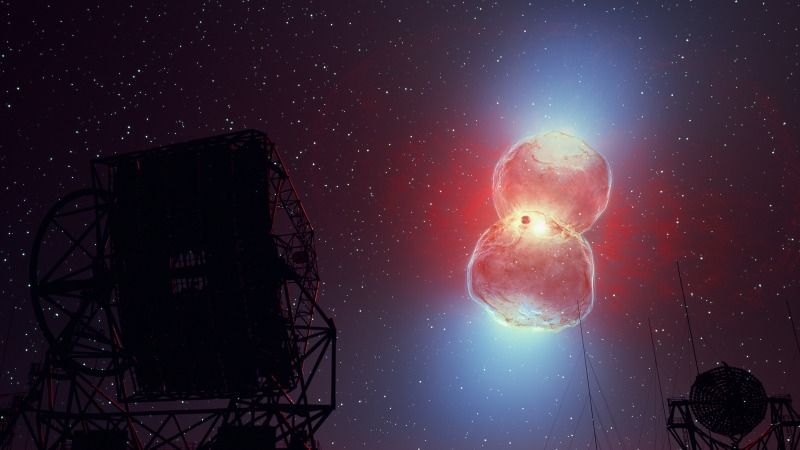A burned-out stellar core produced a shockwave that pushed particles to their theoretical speed limit, scientists have reported.
Astronomers used a gamma-ray observatory in Namibia called the High Energy Stereoscopic System (HESS) to show how an eruption creates a shock wave that accelerates material around it super-fast speeds. The research focused on RS Ophiuchi, a nova that erupts every 15 to 20 years — most recently, in 2021.
RS Ophiuchi’s system includes one normal star and one white dwarf, the cold dense core that remains after a star explodes. The white dwarf pulls matter off the star, and when the stellar corpse has swallowed enough material, it produces the eruption scientists call a nova. As the nova erupts, the resulting shock wave collides through the surrounding area, pulling particles along with it and creating an accelerator that turns out to be incredibly powerful.
Supernova photos: Great images of star explosions
“When the nova exploded in August 2021, the HESS telescopes allowed us to observe a galactic explosion in very-high-energy gamma rays for the first time,” noted principal investigator Alison Mitchell, researcher at Friedrich-Alexander-Universität Erlangen-Nürnberg in Germany, in a statement Thursday (March 10).
Notably, particles at RS Ophiuchi reached rates hundreds of times faster than scientists have ever observed at other novas. The acceleration was so powerful that the particles reached the maximum speed predicted in theoretical models, the team behind the new research noted.
“The observation that the theoretical limit for particle acceleration can actually be reached in genuine cosmic shock waves has enormous implications for astrophysics,” co-author Ruslan Konno, a doctoral candidate at Deutsches Elektronen-Synchrotron in Germany, said in the same statement. “It suggests that the acceleration process could be just as efficient in their much more extreme relatives, supernovas.”
Supernovas are stellar explosions generated when the most massive stars run out of fuel and are in fact the process that creates white dwarfs like the one in RS Ophiuchi.
In addition to tracking the eruption as it progressed, the researchers were able to measure high-energy gamma-rays from the RS Ophiuchi nova up to a month after the explosion. Such observations are the first of their kind, according to the statement.
The RS Ophiuchi nova may not be the largest explosion out there, but for scientists these observations are particularly special, made possible only by a cutting-edge camera that HESS installed on one of its telescopes in late 2019. The newness of the technology means scientists aren’t yet sure how rare this type of event is.
The HESS observations also relied on amateur astronomers swiftly reporting their sightings of the nova to professional counterparts, according to the statement.
The researchers said that the study has implications not only for novas and supernovas, but perhaps also for better understanding the origin story of cosmic rays. Cosmic rays are energetic explosions that appear to come from every direction in space, making their source difficult to trace, but having studied the RS Ophiuchi nova, the researchers have a hunch that this type of nova might play a role.
A study based on the research was published on Thursday (March 10) in Science.
Follow Elizabeth Howell on Twitter @howellspace. Follow us on Twitter @Spacedotcom or Facebook.

